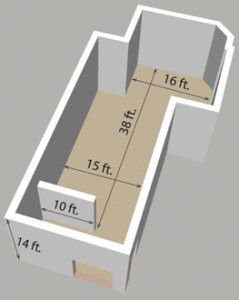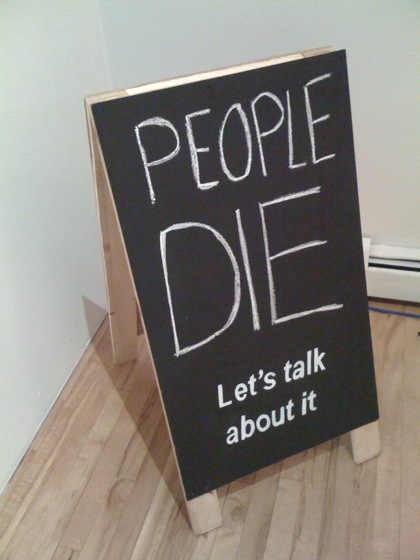Apexart’s New Show
I got a postcard about Apexart‘s new show, The Incidental Person, but it didn’t really say what the group show was about, and I forgot to look it up online before stopping by. Having seen the show, I’m still not sure what it was about. To be fair, there may have been materials that explained it, but when I walked in the staff (?) was having a meeting just inside the front door, and I felt awkward enough interrupting them once that I didn’t want to do it again.
Perhaps exhibits don’t need themes. I enjoyed The Incidental Person even if I couldn’t tell what brought the works together. Two highlights were this signboard by Ariana Jacob…
…and the Dial-a-Cheer project by Lexa Walsh. If you call in or email whatever you need pumping up about, the cheerleaders will create a cheer and videotape it, and it’ll be available at the gallery. I’ve just emailed asking for one, so if you visit Apexart next week, keep an eye out for it.
Afterward, I went online to find out what the show was about. Um, see the * below, where I pasted the text I found.
 If you think curating is so easy, I hear you thinking, why don’t you try doing it yourself? Actually, thanks to Apexart, I may have a chance to do just that. Schmoes like me, with no art experience, can submit exhibit proposals to Apexart; its panel of “curators, artists, writers, and philosophers” will choose two to be mounted in the 2010-11 season. The full rundown of info is at apexart.org/unsolicited.htm. I have an idea….
If you think curating is so easy, I hear you thinking, why don’t you try doing it yourself? Actually, thanks to Apexart, I may have a chance to do just that. Schmoes like me, with no art experience, can submit exhibit proposals to Apexart; its panel of “curators, artists, writers, and philosophers” will choose two to be mounted in the 2010-11 season. The full rundown of info is at apexart.org/unsolicited.htm. I have an idea….
* The late British artist John Latham (1921-2006) coined the expression “the Incidental Person” in the context of Artist Placement Group, known as APG, which he co-founded in 1966 with Barbara Steveni, Jeffrey Shaw and Barry Flanagan. Contrary to most artist placement schemes, APG emphasized process, interaction and the artist’s independence in relation to the host institution, rather than any short-term tangible outcome. Like an unbiased observer or a third-party mediator, the Incidental Person placed through APG in industry, government, education or the non-profit sector would negotiate the terms of the invitation from the institution in question and adapt the nature of her or his intervention accordingly. This incidental function, as Latham explained, “is more to watch the doings and listen to the noises, and to eliminate from the output the signs of a received idea as being of the work.” Latham stresses the incidental person’s approach, that is, a certain position or attitude vis-à-vis the context in which she or he is placed. In other words, the identity of the incidental person is secondary to the effect she or he has on a given situation, for the aim of the incidental person is not to be anything in particular but instead “to generate maximum public involvement, and maximum enthusiasm which goes with the involvement.”
It is high time to pay renewed attention to incidentality as an effective approach to pressing societal issues. Away from the rudimentary right/left or liberal/conservative labels that paralyze governments and polarize communities, the incidental attitude is one of self-reflexiveness and acute, humble awareness of the complex networks of local pressures that inform a specific time and place. We like to assign tags to artists who engage with problematics that exceed the confines of the so-called “art world”, such as socially- or politically-engaged, relational, performative, etc. But these qualifiers only serve to quarantine the curious thinker-doer further from society at large, reinforcing the myth of the artist as exempt from participating in the “real world.” The incidental person, by contrast, sees no alternative between “art” and the activities that regulate social coexistence, such as talking, playing, eating, reading, teaching and listening. Indeed, “art” itself — as a word corresponding to a distinct class of objects or actions — dissolves, becoming just another term for the disposition of someone whose incidental relation to the context in which she or he intervenes is simultaneously internal and external: internal to the context’s unique dynamics, but sufficiently external to it to be able to see its relevance to broader questions of “life-practice” or “the everyday” (but such phrases, too, are merely expedient equivalents for something even more incidental).
In recounting the origins of APG, Barbara Steveni has said that the initial incident occurred when Robert Filliou and Daniel Spoerri, who were staying with her and John Latham to prepare an exhibition in London, needed some found material. Despite the late hour, Steveni offered to collect whatever she could find at an industrial site beyond the city limits. Sifting through debris while the factory was in full activity, she experienced a “eureka” moment, as she put it: “Why aren’t we here? Not to pick up buckets of plastic, but because there’s a whole life that we don’t touch. This is what people go on about — academics, artists, politicians — but they go nowhere near it.” This exhibition includes projects by people who attempt precisely to “touch” what is “out there”, who, while meticulously attentive to the context at hand, refuse to hew to such distinctions as art/non-art, art/life or art/politics.















